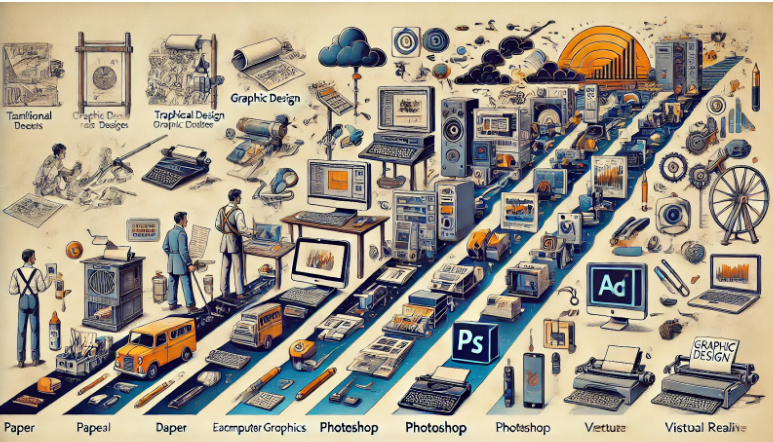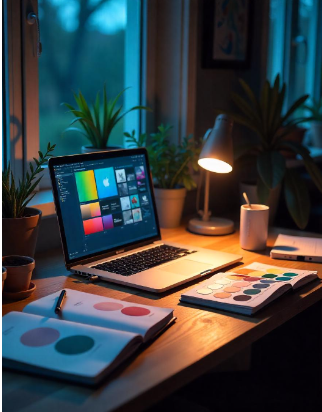Graphic designing has evolved into a critical component of modern business, marketing, and branding efforts. No longer confined to print media, graphic design plays a vital role in digital platforms, including social media, websites, and e-commerce. But how far can graphic designing take you in today’s world? Let’s explore the scope and opportunities in this exciting field.
How Has the Role of Graphic Designers Evolved Over Time?

Graphic designing has come a long way since its early days of traditional print media. Today, with the advent of digital platforms, the scope has expanded beyond logos, brochures, and billboards. The rise of social media, e-commerce, mobile apps, and online marketing has created an extraordinary demand for graphic designers.
Graphic designers are now responsible for shaping brand identities, crafting user experiences, and creating dynamic content that engages audiences across various platforms. Whether it’s designing the layout of a website or creating eye-catching social media visuals, their role has become far more strategic and essential to business success.
Why is Graphic Designing So Important for Business Growth?


In the age of digital transformation, businesses of all sizes understand that great designs can make or break their success. Here’s why graphic designing is a critical component of growth:
- Brand Identity and Recognition: Graphics create a strong visual identity for brands, helping them stand out in a crowded marketplace. Consistent and thoughtful design across platforms helps businesses build recognition and trust with their audience.
- Improved User Experience (UX): Websites, mobile apps, and digital interfaces rely heavily on graphic designers to ensure a seamless user experience. The better the design, the easier it is for customers to navigate through products and services, resulting in increased sales and conversions.
- Effective Communication: Visual storytelling is key to engage with your audiences today. Graphics helps communicate complex ideas in a simplified, attractive manner, making the content more appealing and easier to understand.
- Digital Marketing and Social Media: The rise of digital marketing has pushed graphic designers into the forefront of advertising. Ads, infographics, and promotional content across social media rely on strong designs to capture attention and drive engagement.
What Career Opportunities are Available for Graphic Designers?


The scope of graphic designing isn’t limited to just one industry or role. In fact, graphic designers have the flexibility to work across a wide range of sectors and can even choose between freelance work, full-time positions, or entrepreneurial ventures. Here are some career paths within graphic design:
- UI/UX Designer: Designing user-friendly interfaces for websites, mobile apps, and software has become one of the most lucrative and in-demand areas in graphic designing.
- Branding Specialist: This role involves crafting a brand’s identity, including logos, color schemes, and overall visual style, to create a cohesive image for businesses.
- Social Media Designer: With social media becoming a dominant form of marketing, there’s a growing need for designers who can create visually compelling posts, ads, and stories for platforms like Instagram, Facebook, and LinkedIn.
- Packaging Designer: For companies selling physical products, packaging design plays a vital role in attracting customers and reflecting the brand’s values.
- Illustrator and Animator: Graphic designers who specialize in illustrations and animations are in demand for content creation across advertising, web development, and multimedia platforms.
What Skills are Required to Succeed in Graphic Design?


Achieving success as a graphic designer involves more than just having an eye for design. Here are the key skills that make for a thriving career in the field:
- Creative Thinking: The ability to think outside the box and come up with innovative solutions is crucial in graphic design. Each project is different and requires unique approaches.
- Technical Proficiency: A strong command of design tools like Adobe Creative Suite (Photoshop, Illustrator, InDesign) and other relevant software is crucial for creating professional designs. Additionally, knowing web design tools like Figma or Sketch can open doors to UI/UX roles.
- Attention to Detail: Designers need to be meticulous when it comes to typography, color schemes, and spacing. Every small detail contributes to the overall effectiveness of the design.
- Communication Skills: Working with clients, marketing teams, or developers means that graphic designers must be able to explain their concepts and ideas clearly. Understanding client needs and translating them into visuals is a key part of the job.
What Tools Can Beginners Use to Start in Graphic Designing?


If you’re a beginner in graphic design, there are several easy-to-use tools that can help you get started without needing advanced technical skills. Here are some beginner-friendly graphic design tools:
- Canva: Canva is a versatile and widely-used online design tool perfect for beginners. It offers thousands of templates for creating everything from social media graphics to presentations and posters. Its drag-and-drop interface makes it easy to create professional-looking designs without any prior experience.
- Fabricodes: Fabricodes is a fantastic platform specifically designed for creators who need visually appealing thumbnails, social media posts, and other graphical elements. If you’re a content creator on YouTube or Instagram, Fabricodes is perfect for designing eye-catching thumbnails that attract attention and drive engagement.
- Snappa: Snappa is a user-friendly designing tool designed for quick and easy graphic creation. It’s a great alternative to Canva if you want a simple tool without too many complex features. Ideal for small businesses, freelancers, and solopreneurs looking for speed and simplicity.
- Fotor: Fotor is primarily known as an online photo editor, but it’s also an excellent design tool. Like Canva, Fotor offers a variety of templates for social media, print materials, and marketing content. If your focus is more on image editing, Fotor is a great choice for professional-looking graphics and photos.
Is Graphic Designing a Stable Career Choice for the Future?


With the growing reliance on digital platforms, visual content, and branding, the demand for graphic designers is unlikely to slow down anytime soon. As businesses increasingly prioritize online presence and user experience, graphic designers will continue to play a critical role in shaping the digital world.
Furthermore, as technology evolves and new design tools emerge, there are ample opportunities for growth and advancement in the field. Whether you’re passionate about branding, digital marketing, or UI/UX design, graphic design offers a stable and dynamic career path.
Conclusion
Graphic designing is a field that offers a blend of creativity and strategy, making it a rewarding career for those who have a passion for visual communication. Whether you’re interested in branding, UI/UX, or digital marketing, the scope of graphic designing is vast and full of opportunities.
As businesses increasingly recognize the value of strong design, the future for graphic designers looks bright. If you have the skills, creativity, and adaptability, there’s no limit to what you can achieve in this dynamic and growing industry.

